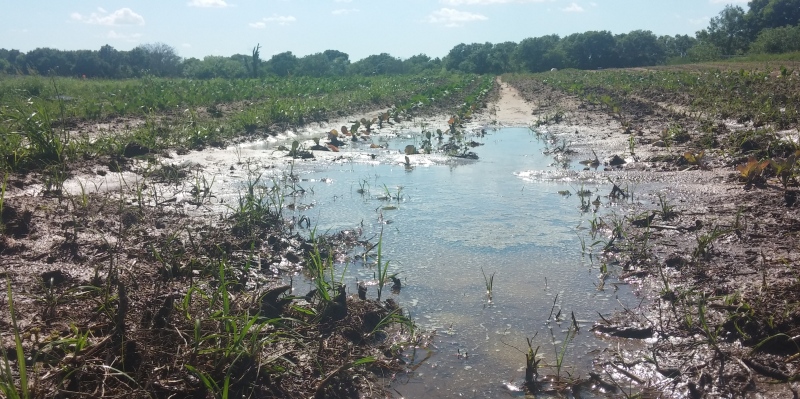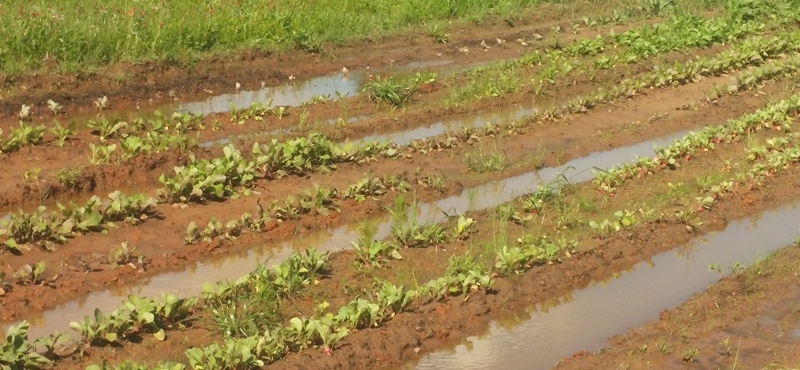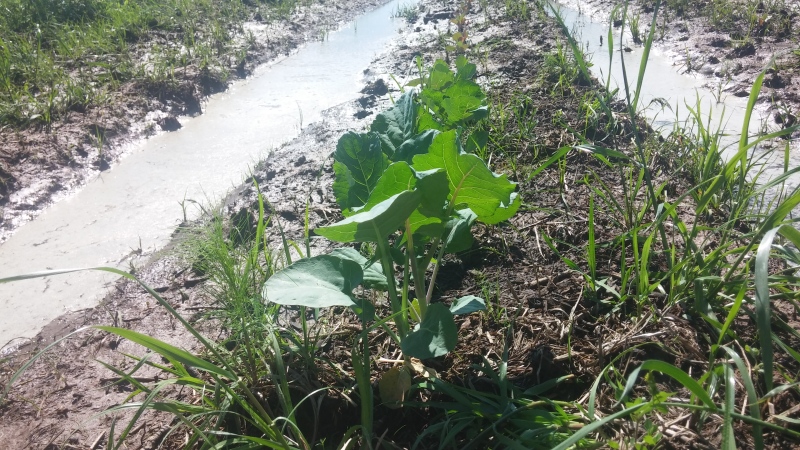Our plants can swim!
Did you know our garden plants could swim? We didn’t either!
In an average year, this area sees about 43 inches of rain, with about 13 of those inches falling by late April. Last year was a bit on the dry side, and we saw 4.5 inches of rain by late April. This year? We’ve already seen 27 inches and we could likely have a couple more later this week. Usually in Texas we are praying for more rain, but this is definitely more than we’d like to see. With this amount of rainfall, the garden has a few primary problems.
1. When the soil stays wet for too long without drying out, the healthy oxygen and microbe-rich environment we have facilitated for the past few seasons either goes dormant, or becomes anaerobic. Organic matter (such as compost) breaks down extremely rapidly in an anaerobic environment and can even turn to alcohol in the oxygen-deprived soil. In saturated soil the roots of the plants cannot transmit or synthesize nutrients to the leaves, and the plant respiration is disrupted (yes, plants breathe through tiny pores on the leaf surface. Cool huh?). The plants become nutrient- and water-stressed, and begin to droop as if they are thirsty, but they’re actually oxygen deprived, not thirsty. If sitting in this environment long enough, the plants can become diseased or permanently stunted. Basically without healthy oxygen levels and healthy microbes, you don’t have healthy soil or healthy plants.
Below you can see that the rows of plants are pretty healthy and about 6-10″ tall on the far left and right of the image. Notice how in the center of the image where the water is deepest, they are thin and 1-2″ tall. This area has not had the time to dry out and get oxygen to the roots of the plants.
2. In order to prepare a fresh garden bed for planting, we drive the tractor down the row and loosen the soil with our tiller and incorporate compost. When conditions are too wet, the tractor will get stuck in the mud. Even if the sun is shining and the weather gorgeous, if the ground is still damp from the previous rain, we must wait patiently for drier conditions, crossing our fingers it doesn’t rain again in the meantime. With lots of wonderful hired farmhands, we rushed out into the garden on every sunny, dry day we had this spring to get the garden planted in late March and early April, but the crops are still a little behind.
3. After planting seeds into freshly tilled soil, a farmer hopes for a nice, slow, gentle rain to moisten the ground and help the seeds germinate. When a very hard rain falls on a freshly tilled piece of ground, the light particles of soil and the tiny seeds can be picked up by the large volume of water and carried quite a distance. Also, when the soil is moved around by a fast falling rain, tiny tender sprouts can get covered up with soil and subsequently choked of the sunlight they need to survive. This happened a few times this spring to plantings of mustard, carrots, turnip, and beet, so we got back out there and planted again. And with some crops we did it yet another time. And if we have to, we’ll do it yet again.
4. When conditions are mucky, we cannot cultivate the soil and remove the weeds from near the plants. Because many of the weeds are hearty or native species, they often continue thriving through moist conditions and begin to crowd out the garden plants. As soon as the ground dries out enough to weed, you bet your butt we’ll be out there all day knocking the weeds back.
With good conditions, the ground will dry, the crops will grow well, and the harvest will be abundant. And until then, you might catch us praying for no more rain.
Your farmers,
Jessica and Justin


